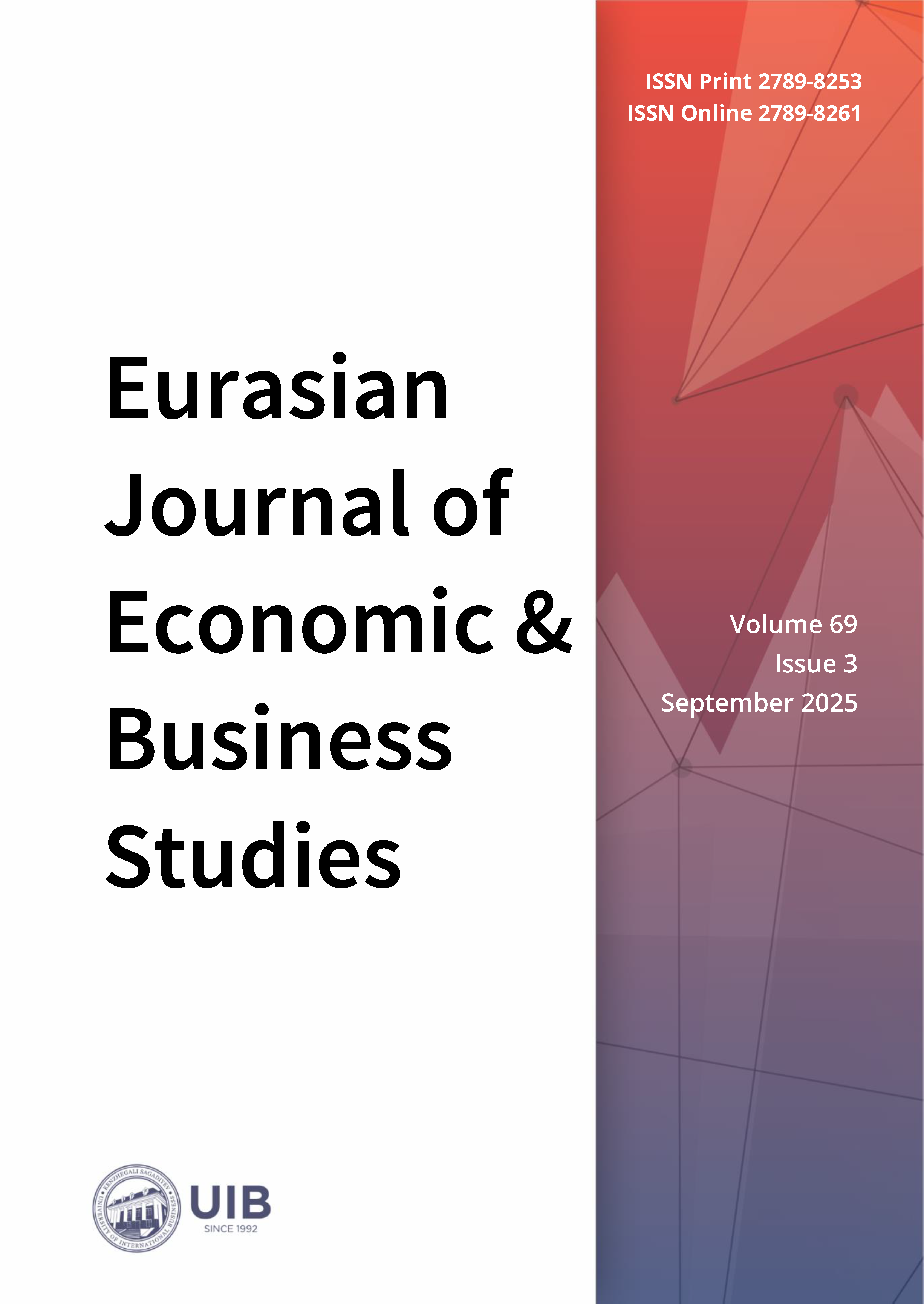More Freedom, Less Equality: The Unexpected Economics of Abortion in Central Asia
DOI:
https://doi.org/10.47703/ejebs.v69i3.547Keywords:
Abortion Economics, Gender Economy, Gender Pay Gap, Female Labor, Women’s Economic Empowerment, Income Inequality, Kazakhstan, KyrgyzstanAbstract
Few papers about Central Asia explore the economic effects of abortion on women. This econometric paper the objective is to assess whether abortions in Kazakhstan and Kyrgyzstan are associated with women’s economic empowerment. The study finds that when abortions increase, measures of female relative income decrease, in both simple correlations and Ordinary Least Squares regressions. The annual series for 2002-2022 and comparable aggregates for the two countries are used (a total of 32 observations on key variables), where the gender pay gap is defined as the ratio of the average incomes of women to the incomes of men. This implied that Kazakhstan and Kyrgyzstan had different permanent institutions, such as the labor market. Instrumental-variable analysis, which controls for the impact of the model itself on abortion estimates, showed that a rise of one abortion per 1,000 live births led to a 2% decrease in the female-to-male ratio of average income. The descriptive part reveals a stable negative relationship between abortions and women's relative income: for the 2011-2022 subsample in Kazakhstan, the simple correlation is about -0.63 (statistically significant), which is consistent with the “constraints” hypothesis. The paper concludes that female economic empowerment in Central Asia may depend more on institutions and social structures than on individuals’ short-term reproductive decisions, such as whether to have an abortion. The findings contradict the theory that abortion empowers women economically by freeing them from raising children so that they can pursue education and careers.
Downloads
References
Agadjanian, V., & Dommaraju, P. (2011). Culture, modernization, and politics: Ethnic differences in union formation in Kyrgyzstan. European Journal of Population/Revue européenne de Démographie, 27(1), 79-101. https://doi.org/10.1007/s10680-010-9225-7 DOI: https://doi.org/10.1007/s10680-010-9225-7
Ananat, E. O., Gruber, J., Levine, P. B., & Staiger, D. (2009). Abortion and selection. The Review of Economics and Statistics, 91(1), 124-136. https://doi.org/10.1162/rest.91.1.124 DOI: https://doi.org/10.1162/rest.91.1.124
Angrist, J., & Evans, W. N. (1996). Schooling and labor market consequences of the 1970 state abortion reforms (NBER Working Paper No. 5406). National Bureau of Economic Research. http://doi.org/10.3386/w5406 DOI: https://doi.org/10.3386/w5406
Bearak, J., Popinchalk, A., Ganatra, B., Moller, A. B., Tunçalp, Ö., Beavin, C., ... & Alkema, L. (2020). Unintended pregnancy and abortion by income, region, and the legal status of abortion: estimates from a comprehensive model for 1990–2019. The Lancet Global Health, 8(9), e1152-e1161. https://doi.org/10.1016/S2214-109X(20)30315-6 DOI: https://doi.org/10.1016/S2214-109X(20)30315-6
Bozgorpoeva, B. (2024). Improving abortion services in Kyrgyzstan. SAAF. https://saafund.org/improving-abortion-services-in-kyrgyzstan/
Bureau of National Statistics. (2024). Bureau of National Statistics of the Republic of Kazakhstan. Retrieved September 25, 2025 from https://stat.gov.kz/en
Cooley, D., & Chesnokova, I. (2011). Sex selection abortion in Kazakhstan: understanding a cultural justification. Developing World Bioethics, 11(3), 154-160. https://doi.org/10.1111/j.1471-8847.2011.00303.x DOI: https://doi.org/10.1111/j.1471-8847.2011.00303.x
Drezgić, R. (2010). Policies and practices of fertility control under the state socialism. The History of the Family, 15(2), 191-205. https://doi.org/10.1016/j.hisfam.2009.11.001 DOI: https://doi.org/10.1016/j.hisfam.2009.11.001
Guttmacher Institute. (2020). Kazakhstan country profile: Trends in unintended pregnancy and abortion, 1990–1994 to 2015–2019. Guttmacher Institute. https://www.guttmacher.org/regions/asia/kazakhstan
Hilevych, Y. (2015). Abortion and gender relationships in Ukraine, 1955–1970. The History of the Family, 20(1), 86-105. https://doi.org/10.1080/1081602X.2014.996913 DOI: https://doi.org/10.1080/1081602X.2014.996913
International Planned Parenthood Federation European Network. (n.d.). IPPF Europe & Central Asia. Retrieved September 25, 2025, from https://europe.ippf.org/
Johnson Jr, B. R., Maksutova, E., Boobekova, A., Davletova, A., Kazakbaeva, C., Kondrateva, Y., ... & Jo, A. H. S. (2018). Provision of medical abortion by midlevel healthcare providers in Kyrgyzstan: testing an intervention to expand safe abortion services to underserved rural and periurban areas. Contraception, 97(2), 160-166. https://doi.org/10.1016/j.contraception.2017.11.002 DOI: https://doi.org/10.1016/j.contraception.2017.11.002
Johnston, W. R. (2025). Historical abortion statistics, Kazakhstan. Retrieved September 25, 2025, from https://www.johnstonsarchive.net/policy/abortion/ab-kazakhstan.html
Kan, M. (2024). Religion and contraceptive use in Kazakhstan. Demographic Research, 50, 547-582. https://www.jstor.org/stable/48766153 DOI: https://doi.org/10.4054/DemRes.2024.50.21
Kovaleva, I., & Taylor, L. (2023). Why do women work harder than men? Testing the Patrilocality Hypothesis. Qual Prim Care, 31, 31. https://www.primescholars.com/articles/why-do-women-work-harder-than-men-testing-the-patrilocality-hypothesis-123704.html DOI: https://doi.org/10.21203/rs.3.rs-3191790/v1
Kovaleva, I., Taylor, L., Pech, G., Madumarov, E., & Korosteleva, A. (2025a). From household duties to innovation: the role of gender norms in women’s economic participation. Buketov Business Review, 11830(2), 41-53. https://doi.org/10.31489/2025ec2/41-53 DOI: https://doi.org/10.31489/2025ec2/41-53
Kovaleva, I., Taylor, L., Pech, G., & Madumarov, E. (2025b). What household structure encourages innovation? Comparative analysis of a case study of female labor in Kyrgyzstan and Kazakhstan. Buketov Business Review, 11730(1), 30-42. https://doi.org/10.31489/2025ec1/30-42 DOI: https://doi.org/10.31489/2025ec1/30-42
Meh, C., & Jha, P. (2022). Trends in female-selective abortion among Asian diasporas in the United States, United Kingdom, Canada and Australia. Elife, 11, e79853. https://doi.org/10.7554/eLife.79853 DOI: https://doi.org/10.7554/eLife.79853
Mogilevkina, I., Markote, S., Avakyan, Y., Mrochek, L., Liljestrand, J., & Hellberg, D. (1996). Induced abortions and childbirths: trends in Estonia, Latvia, Lithuania, Russia, Belarussia and the Ukraine during 1970 to 1994. Acta obstetricia et gynecologica Scandinavica, 75(10), 908-911. https://doi.org/10.3109/00016349609055026 DOI: https://doi.org/10.3109/00016349609055026
National Statistical Committee of the Kyrgyz Republic. (2024). Statistics of the Kyrgyz Republic. Retrieved September 25, 2025, from https://www.stat.gov.kg/en/
Newbury, J. (1981). Linear Interpolation. In: Basic numeracy skills and practice. Palgrave, London. https://doi.org/10.1007/978-1-349-05558-6_16 DOI: https://doi.org/10.1007/978-1-349-05558-6
Ozili, P. K. (2023). The acceptable R-square in empirical modelling for social science research. In Social research methodology and publishing results: A guide to non-native English speakers (pp. 134-143). IGI global. http://dx.doi.org/10.2139/ssrn.4128165 DOI: https://doi.org/10.4018/978-1-6684-6859-3.ch009
Rotkirch, A., & Kesseli, K. (2010). ’The first child is the fruit of love’. on the Russian tradition of early first births. Witnessing change in contemporary Russia, 201-220. The-First-Child-is-the-Fruit-of-Love-On-the-Russian-Tradition-of-Early-First-Births.pdf
Sarsenova, A., Imanbayeva, S., Syzdykova, M., & Abdramanova, A. (2024). Features of Development of Sexual Culture of Youth in Kazakhstan. Sexuality & Culture, 28(5), 2191-2206. https://doi.org/10.1007/s12119-024-10225-z DOI: https://doi.org/10.1007/s12119-024-10225-z
Schief, M., Vogt, S., Churilova,, E., & Efferson, C. (2024). Isolating a culture of son preference among Armenian, Georgian and Azeri Parents in Soviet-era Russia. Evolutionary Human Sciences, 6: 1-13. http://doi.org/10.1017/ehs.2024.9 DOI: https://doi.org/10.1017/ehs.2024.9
Sedgh, G., Ashford, L. S., & Hussain, R. (2016). Unmet need for contraception in developing countries: examining women’s reasons for not using a method. Guttmacher Institute. Retrieved September 25, 2025, from https://www.guttmacher.org/report/unmet-need-for-contraception-in-developing-countries
Szreter, S. (2002). Fertility, class and gender in Britain, 1860-1940 (No. 27). Cambridge University Press. https://doi.org/10.1017/CBO9780511582240 DOI: https://doi.org/10.1017/CBO9780511582240
United Nations Convention on the Rights of the Child (UNCRC). (2015). Concluding observations on the fourth periodic report of Kazakhstan. Retrieved September 25, 2025, from https://documents-dds-ny.un.org/doc/UNDOC/GEN/G15/248/14/PDF/G1524814.pdf?OpenElement
United Nations Development Programme. (2022). Human Development Index (HDI). Retrieved September 25, 2025, from https://hdr.undp.org
United Nations Population Fund (UNFPA). (2023). Youth-friendly services scaling up in Kazakhstan, offering critical sexual and reproductive health. UNFPA. Retrieved September 25, 2025, from https://www.unfpa.org/news/youth-friendly-services-scaling-kazakhstan-offering-critical-sexual-and-reproductive-health
United Nations. (2022). Proportion of demand for family planning satisfied with modern methods and adolescent birth rate for Kazakhstan [Data]. UN Women Data. Retrieved September 25, 2025, from https://data.unwomen.org/country/kazakhstan
Urbaeva, Z., Lee, E., & Lee, Y. (2019). Reproductive decisions as mediators between education and employment of women in Kyrgyzstan. Health Care for Women International, 40(7-9), 898-913. https://doi.org/10.1080/07399332.2019.1609963 DOI: https://doi.org/10.1080/07399332.2019.1609963
Westoff, C. F. (2000). The Substitution of Contraception for Abortion in Kazakhstan in the 1990s (No. 1). MEASURE DHS+, ORC Macro. dhsprogram.com/pubs/pdf/AS1/AS1.PDF
Wites, T. (2004). Abortions in Russia before and after the fall of the Soviet Union. Miscellanea Geographica. Regional Studies on Development, 11, 217-228. http://dx.doi.org/10.2478/mgrsd-2004-0025 DOI: https://doi.org/10.2478/mgrsd-2004-0025
World Bank. (2025). World Development Indicators. Retrieved September 25, 2025, from https://databank.worldbank.org/source/world-development-indicators
How to Cite
Downloads
Published
Issue
Section
License

This work is licensed under a Creative Commons Attribution 4.0 International License.
Authors retain copyright and grant the journal right of first publication with the work simultaneously licensed under a Creative Commons Attribution (CC-BY) 4.0 License that allows others to share the work with an acknowledgment of the work’s authorship and initial publication in this journal.



